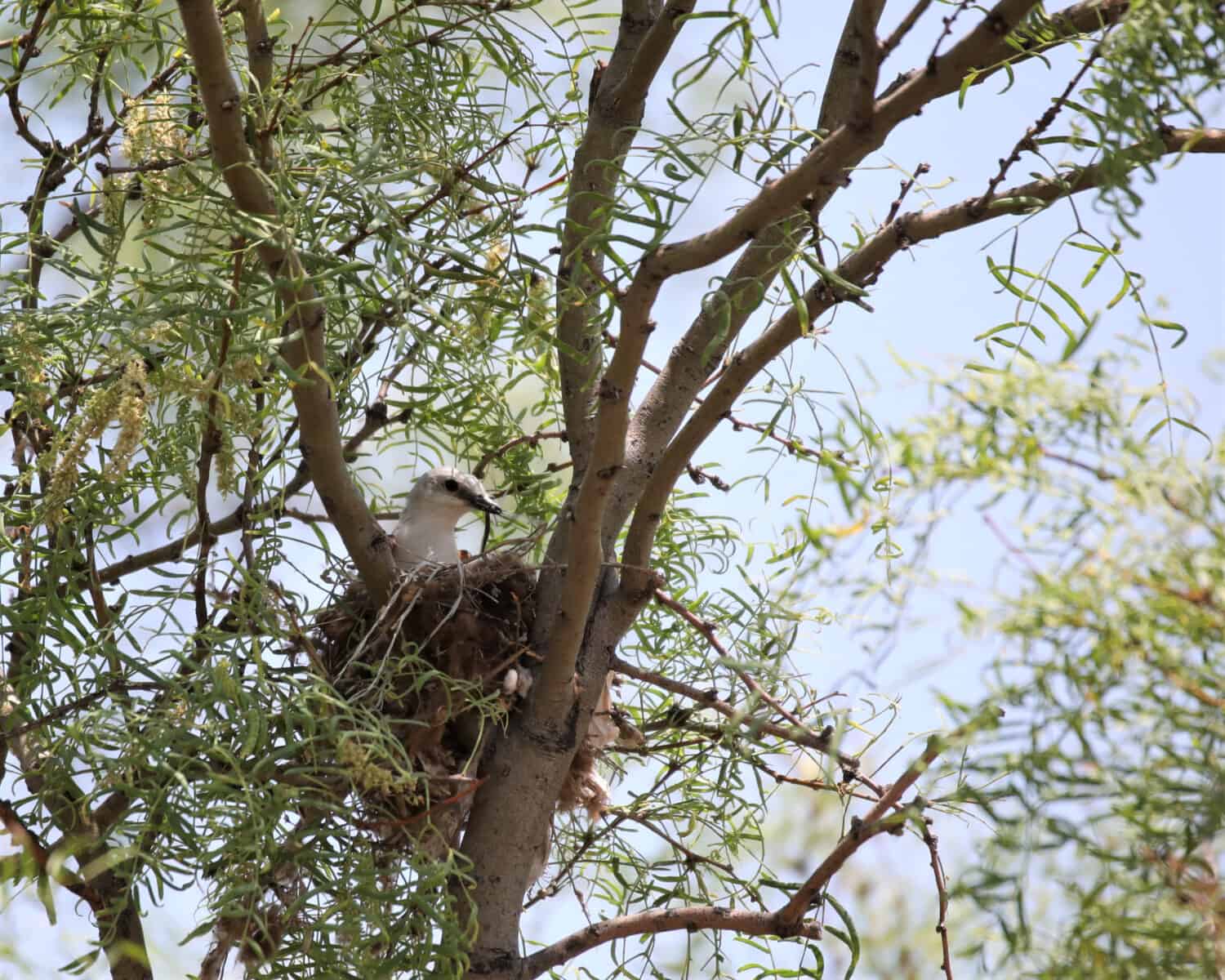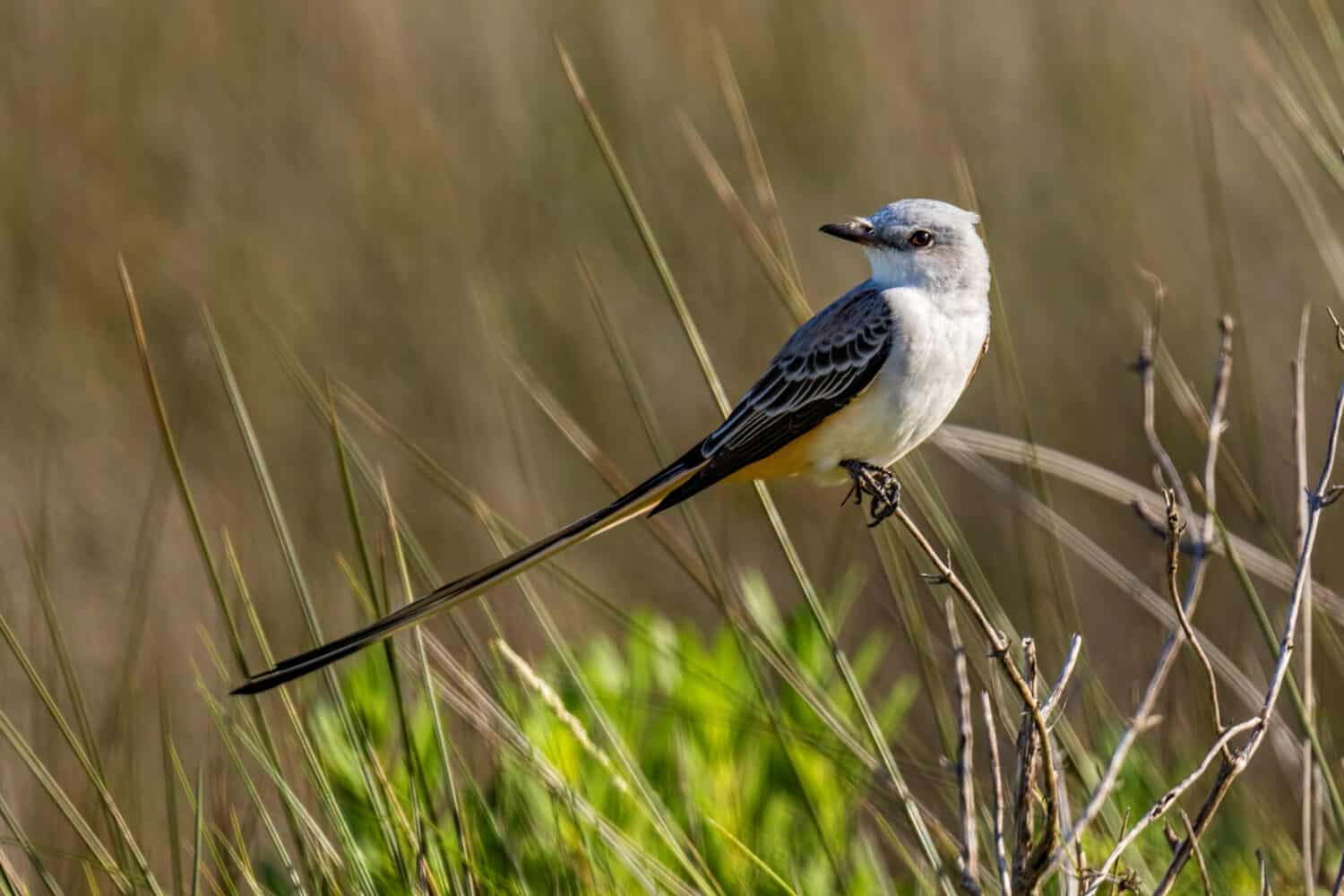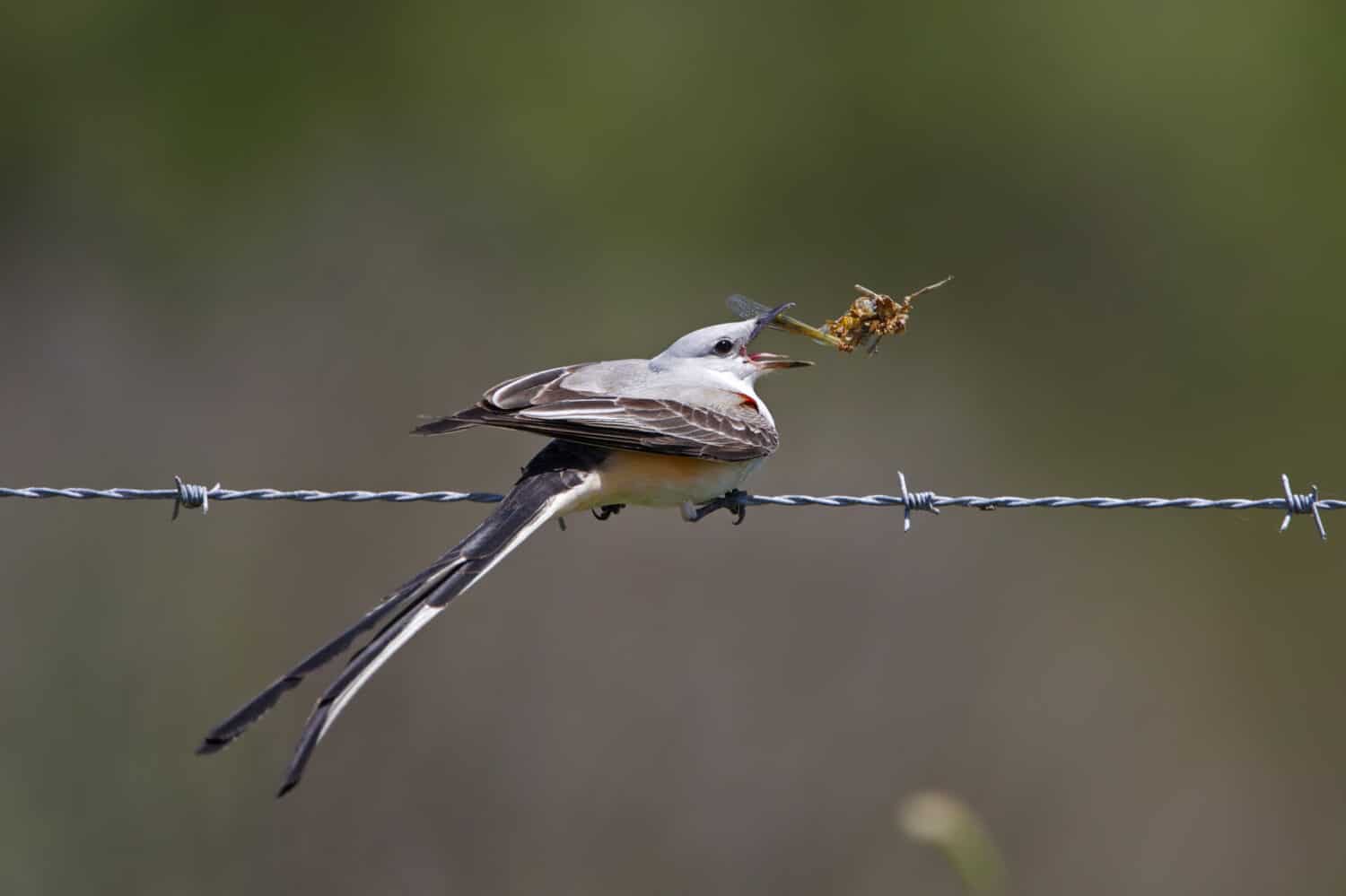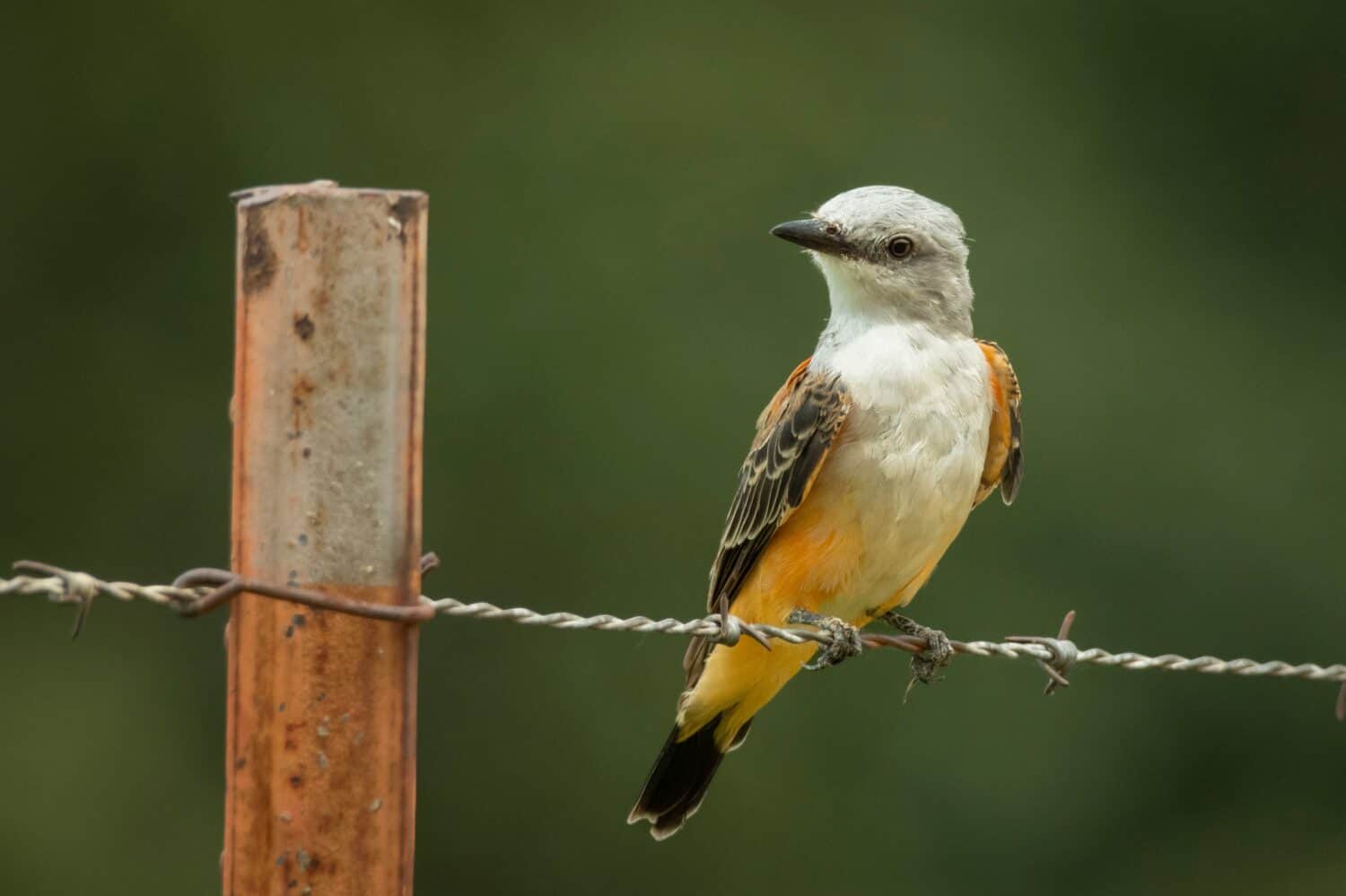Scissor-tailed Flycatcher
Tyrannus forficatus
Scissor-tailed flycatchers are known for their dramatically long tails!
Advertisement
Scissor-tailed Flycatcher Scientific Classification
- Kingdom
- Animalia
- Phylum
- Chordata
- Class
- Aves
- Order
- Passeriformes
- Family
- Tyrannidae
- Genus
- Tyrannus
- Scientific Name
- Tyrannus forficatus
Read our Complete Guide to Classification of Animals.
Scissor-tailed Flycatcher Conservation Status
Scissor-tailed Flycatcher Facts
- Fun Fact
- Scissor-tailed flycatchers are known for their dramatically long tails!
- Wingspan
- 5.9 inches
- Incubation Period
- 13 to 23 days
View all of the Scissor-tailed Flycatcher images!
Scissor-tailed Flycatcher Summary
“Scissor-tailed flycatchers are known for their dramatically long tails!”
The scissor-tailed flycatcher is an elegant species of kingbird. They can be best identified by their long tails. These tails aren’t just for appearance, however, as they help these flycatchers navigate the air and catch insects mid-flight. They are typically found in only a small region. They form large flocks at the end of summer, prior to their migration.
Scissor-tailed Flycatcher Amazing Facts
- Premigratory flocks can contain as many as 1,000 individuals.
- They are one of only two species in the Tyrannus genus with a long, elegant tail.
- Although they are usually only found in a small region in the southern areas of North America, they can wander greatly when migrating, sometimes being recorded as far north as Nova Scotia.
- They will often chase other birds out of their territory.
Where to Find Scissor-tailed Flycatchers
When considering most species of birds with a specific habitat, you can expect to find them only in that range. For the scissor-tailed flycatcher, their habitat includes Texas and the surrounding states, the eastern and southern coastal regions of Mexico, and much of Central America. However, they can be found throughout North America as well, with some individuals being recorded as far north as regions like Nova Scotia and British Columbia.
This species of kingbird prefers savannas, specifically those with sparse trees and sprawling patches of bush abundant with insects. However, during the breeding season, they can also be found in more urban areas, such as pastures and golf courses. The main aspects of this flycatcher’s habitat are perches and open spaces. During the breeding season, they will require trees for nesting.
Scissor-tailed Flycatcher Nests
When it comes to locating the right area to begin the construction of the nest, both the male and female will search the territory. Potential spots will be tested by the pair, with them hopping around the tree or shrub and pressing themselves against the branches. Typically, the spots that ultimately contain the nest are those protected from the wind, as well as those with sparse foliage to shield the nest from some sunlight.
Although she will be escorted by her mate, it is the female alone who builds the nest. There is no single timeline for construction, with some females taking a few days to build the nest and others weeks.
The nest includes a frame using coarse materials, such as plant stems. The inner cup is constructed by tightly weaving together flowers and clothes, and the nest is lined with cotton fibers and thistledown.

These birds build their nests out of a variety of materials.
©Charles Lemar Brown/Shutterstock.com
Scissor-tailed Flycatcher Scientific Name
The scissor-tailed flycatcher is also known as the “Texas bird-of-paradise” and “swallow-tailed flycatcher.” Its scientific name is Tyrannus forficatus.
They are in the class Aves, in the order Passeriformes. The scissor-tailed flycatcher’s family is Tyrannidae. The tyrant flycatcher is the largest family of birds, with over 400 different species.
Scissor-tailed Flycatcher Size, Appearance, and Behavior
The scissor-tailed flycatcher is a rather small bird, although it can appear larger because of its tail. Adults can measure 8.7 to 14.6 inches in length, and they can weigh from 1.3 to 2.0 ounces. They have a wingspan averaging around 5.9 inches.
The overall body of this flycatcher is a pale grey. They have black wings and a black tail. The tips of their tail are white. Males sport more intense colors than their female counterparts, although both sexes have salmon-colored flanks and underwings. These patches can be seen at rest, although they are more noticeable when the scissor-tailed flycatcher is in flight. They have round heads with sharp black beaks.
Scissor-tailed flycatchers spend the majority of their time perched on utility lines, treetops, and fence lines. Here, they are able to watch for prey as well as intruders in their territories. They are able to catch prey mid-flight, a behavior known as “hawking.” They are tolerant of humans and will often nest and raise their young near human areas. This includes towns and other suburban or rural areas.
They are known to be territorial and will attack many other birds, including:
- Hawks
- Turkey vultures
- Mourning doves
- Grackles
- Northern mockingbirds
- Western kingbirds
- Loggerhead shrikes
- House sparrows
- American crows
- Blue jays
- Lark sparrows

You can identify the scissor-tailed flycatcher by its long, elegant tail.
©John L. Absher/Shutterstock.com
Scissor-tailed Flycatcher Migration Pattern and Timing
The scissor-tailed flycatcher is a medium-distance migrant that migrates in both the spring and the fall. They spend their breeding months at the northernmost extent of their range before migrating through Mexico to settle along the southern Mexican coast and Central America for winter.
Although their main habitat includes the south-central United States, eastern Mexico, and Central America, they can be spotted almost everywhere in North America during their migrations.
Scissor-tailed Flycatcher Diet
Scissor-tailed flycatchers are insectivores. However, they will occasionally eat fruit, especially during the winter season.
This species is able to hunt for insects in a variety of ways, choosing to pursue prey either on the ground or up to thirty feet in the air. They will either pluck insects from the ground and vegetation or they will catch them mid-flight. Small prey will be consumed immediately before returning to the scissor-tailed flycatcher’s chosen perch; large prey may be beaten against the perch before consumption.

This flycatcher species is an insectivore.
©Brian Lasenby/Shutterstock.com
What Do Scissor-tailed Flycatchers Eat?
The scissor-tailed flycatcher eats a variety of insects and berries, including:
- Grasshoppers
- Crickets
- Beetles
- Dragonflies
- Red mulberry
- Hackberry.
Scissor-tailed Flycatcher Predators and Threats
As insectivores, one of the biggest threats for the scissor-tailed flycatcher is pesticides. Not all insects will experience a fatal reaction to pesticides. However, the chemicals remain in their bodies. As a result, when these birds eat a large number of insects with these chemicals in their bodies, the chemicals can affect the scissor-tailed flycatcher as well. The same can go for herbicides, which can also enter the bodies of plant-eating insects that may fall prey to this species.
Scissor-tailed flycatchers also face natural threats, such as storms. Severe thunderstorms and tornados can be common in the regions where this species chooses to breed and raise its young. Depending on the location and severity of the storm, it can damage or even destroy nests.
Predators are also a concern for scissor-tailed flycatchers. They are mainly preyed on by birds of prey, although certain reptiles may prey on hatchlings and eggs.
What Eats Scissor-tailed Flycatchers?
The scissor-tailed flycatcher has many different predators. Some of these include:
- Hawks
- Ravens
- Eagles
- Snakes.
Scissor-tailed Flycatcher Reproduction, Babies, and Lifespan
In the early spring months, males will arrive first in the breeding regions. This allows them to go ahead and establish, as well as defend, their chosen territories. Once the females arrive, pairs will form. This pair will work together to maintain the territory while also preparing and building their nest. The breeding pair will remain monogamous for the season, and though they may bond again in later seasons, they may take other mates the next year.
They can have one or two broods per year, each one with anywhere from three to six eggs. The incubation period lasts 13 to 23 days, with hatchlings emerging helpless with sparse down. The nestling period lasts 14 to 17 days after this.
Scissor-tailed flycatchers have a lifespan of 10 to 15 years.

Young scissor-tailed flycatchers lack the long tails of adults.
©ChrisDavidson Photography/Shutterstock.com
Scissor-tailed Flycatcher Population
The scissor-tailed flycatcher is a species of least concern. It is estimated that they have a global breeding population of 9.5 million. However, despite this, they have still faced significant declines in recent years. In nearly half a century, their numbers have declined by 31 percent.
View all 293 animals that start with SScissor-tailed Flycatcher FAQs (Frequently Asked Questions)
Does the scissor-tailed flycatcher migrate?
Yes, both in the spring and in the fall.
How many eggs does the scissor-tailed flycatcher lay?
They lay three to six eggs per brood on average.
What is the scissor-tailed flycatcher's wingspan?
They have a wingspan averaging around 5.9 inches.
When do scissor-tailed flycatchers leave the nest?
The nestling period lasts 14 to 17 days.
Thank you for reading! Have some feedback for us? Contact the AZ Animals editorial team.
Sources
- , Available here: https://onlinelibrary.wiley.com/doi/abs/10.1111/jofo.12239

















